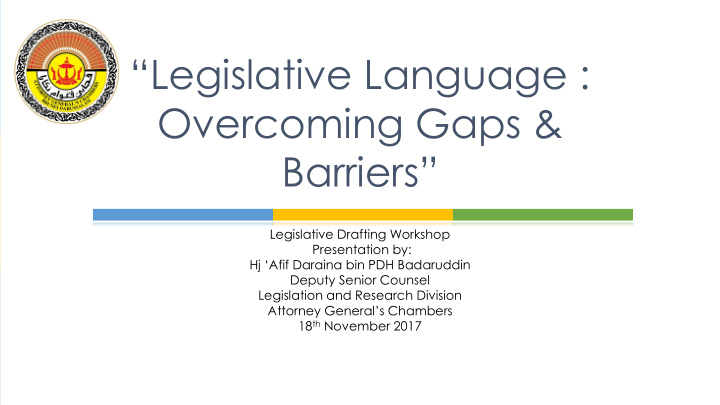



“Legislative Language : Overcoming Gaps & Barriers” Legislative Drafting Workshop Presentation by: Hj ‘Afif Daraina bin PDH Badaruddin Deputy Senior Counsel Legislation and Research Division Attorney General’s Chambers 18 th November 2017
Table of Contents Basic Concept of Legislative Drafting – Formulation of ‘Policy Intent’ Accessibility of Legislation Methodology : Traditional vs Modern Writing Legislation – Why do we draft the way we draft? AGC’s Initiatives Conclusion
Basic Concept of Legislative Drafting Policy Formulation 1 st to be ascertained Details of ‘clear policy intent’ to be made apparent Draft clearly and concisely Hurdles
Accessibility of Legislation “Ignorance of the law is no excuse” In Bowmaker v Tabor [1941] 1 , CA ; Goddard L.J stated: “It is entirely fallacious to say that everyone is presumed to know the law. That fallacy was exposed once and for all by Lord Mansfield in Jones v Randall [1774] 1 Cowp. 37,40 when he said: ‘it would be very hard upon the profession, if the law was certain, that everybody knew it; the misfortune is that it is so uncertain, that it costs money to know what it is, even in the last resort’ . The rule is, that ignorance of the law shall not excuse a man, or relieve him from consequences of a crime, or from liability upon contract. ”
Methodology : Traditional vs Modern ‘ Legalese ’ vs Plain Language Examples: Traditional Modern Give consideration to Consider Make application Apply Pursuant to Under Make an appointment of Appoint To the effect that That Have knowledge of Know In lieu of Instead of
Writing Legislation Why do we draft the way we draft? Judges are not supposed to make laws Foreseeable Contingencies Courts Interpretation
AGC’s Initiatives: Law Revision Act, Chapter 1 AG’s Function and Power to revise written Laws of Brunei To identify and remove repealed Acts To consolidate and alter [NB: Substance of laws being revised remained unchanged] On-going projects – incorporating subsidiary legislation into Laws of Brunei Time Consuming Process – “Authoritative”
Brunei Initiatives: (Cont.) BLUV Project – BruLaw Legislation Updated Version On- line platform accessible through AGC’s website : www.agc.gov.bn Specifically to cater for Orders made under Article 83(3) Brunei Constitution Incorporating amendments to such Orders Virtual text – Not Published nor Printed “Non - Authoritative” – Quick Guide & Reference ONLY Challenges – Limited to scope of allocated resources
Conclusion Formulation of Laws require clear policy-intent Written Laws to be made accessible for everyone Traditional or Modern style of drafting? Mix of both? On-Going Initiatives – ‘Mini Surveys’
~END- Thank you for your attention Questions?
Recommend
More recommend